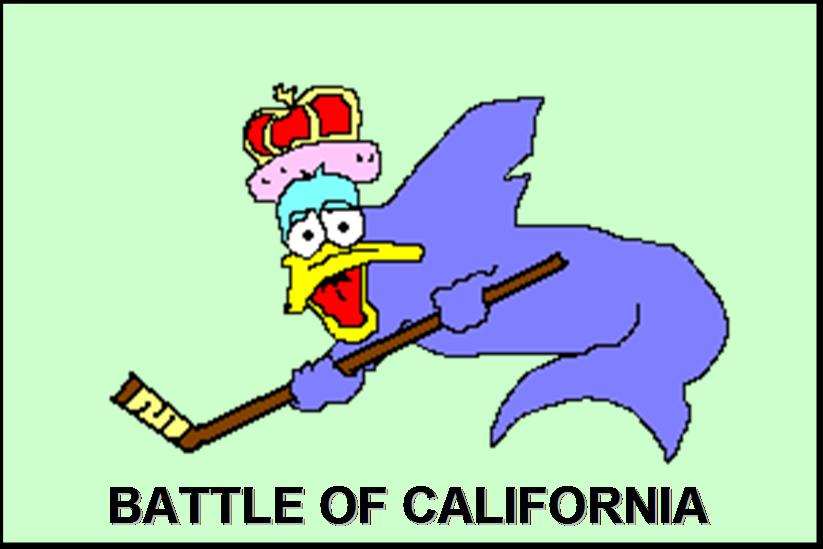OK, math wizards, can you predict on these results?
 I have done a little legwork to figure out the following frequency counts about the Ducks this year. Frequency counts are simplistic in that they do not consider how long situations last, but rather just counts how often situations arise. Anyway, see if you can solve this math puzzle:
I have done a little legwork to figure out the following frequency counts about the Ducks this year. Frequency counts are simplistic in that they do not consider how long situations last, but rather just counts how often situations arise. Anyway, see if you can solve this math puzzle:
The Ducks have been in 59 tied situations this year (29 opening whistles plus another 30 times where a game was re-tied).
35 times the Ducks took the lead (59%)The 35 times the Ducks took the lead,
17 times the opponent took the lead (29%)
7 times the score remained tied to a shootout (12%)
18 times the lead was held and the Ducks won (51%)The 17 times the opponent took the lead
17 times the game was re-tied (49%)
4 times the lead was held and the opponents won (24%)So, math whizzes, just going off these numbers, what is the likelihood of a Ducks win against a dead-average team (equally likely to pull ahead/fall behind, equally likely to hold-lead/re-tie)?
13 times the game was re-tied (76%)
I know this counting method is very rudimentary and probably each of these situations should be weighted according to how much time is left in the game, but I’m not that great a number-crunching guy (at least in bulk). But what I do know is that there are three fundamental aspects to winning—coming back from behind, pulling ahead, and staying ahead—and in my opinion how they happen isn’t as important as that they happen. These three attributes, in essence, define winning.
In this counting method, it doesn’t matter if a leading team scores eight more goals or not. What matters is that given this lead, do they finish with it or not? If the game re-ties, can they re-establish a lead? If things go sour, can they come back?
Thoughts? Interest? Does any of this make any sense?
(I should note that I would like to see these numbers for other teams to compare against, but this took me a long time to do for the Ducks, and certainly there’s others on this “internet” that could produce these numbers much more easily if the concept is interesting.)









8 comments:
I did a quick simulation with this data (100,000 tries):
W = 61%
T = 25%
L = 14%
It would be interesting to see if two teams dynamics could predict outcomes.
Problem with these statistics is there are only 60 events for ties, 35 for wins, 17 for losses, the error makes these results useless, where as GF, GA is less prone to this error.
For example, this predicts twice as many shootouts as normally occur, so A. Anaheim likes the shootout, B. They've just got more shootouts than average.
Also goals/game = 2.82, which is way too low....
I wouldn't be concerned too much about goals/game. I think this method doesn't attempt to predict actual score.
It doesn't care whether a trailing team (down 1-0) ties the game at 1-1 or 3-3. It only cares whether the game ever gets tied again.
Problem with these statistics is there are only 60 events for ties, 35 for wins, 17 for losses, the error makes these results useless, where as GF, GA is less prone to this error.
Yeah, we're not drawing conclusions based on very much, that's true. However, I think it is based a little more on what it is we are trying to predict and not some proxy (gf, ga).
Mostly I'm just wondering whether some approach like this, while awfully simplistic, has any predictive merit at all.
Math scares the bejeezus out of me. I don't know how you do it.
I'm with HG - Math is bad!
However I do know that when the Sabres were in their season beginning win streak, they were winning tons of games by coming from behind and taking the game over. I do think that's definitely important.
This is kind of interesting actually even if it is math!
Math scares the bejeezus out of me.
Math is bad!
Hey, kids (might) read this site! Finish your math homework, kids!
(and parents—what are you doin' letting your kids read this site?!)
Fret not, math-o-phobes! I am quite schizophrenic, and my polar-opposite-personality hates math posts!
I wouldn't joke about math.
Math Kills.
Problem with these statistics is there are only 60 events for ties, 35 for wins, 17 for losses, the error makes these results useless, where as GF, GA is less prone to this error.
I'm not the best thinker when it comes to "statistical relevance" or "error", but would these stats be more "meaningful" if we counted the overall time that a game was spent trailing/tied/leading?
That would at least give us more "observation" counts.
Of course, that also remains outside of my ability to tally.
Post a Comment